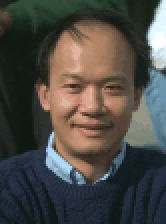Building and Using A Scalable Display Wall
 Kai
Li, Princeton University
Kai
Li, Princeton University
li@cs.princeton.edu
Seminar on People, Computers,
and Design
Stanford University November 10, 2000
While most computer technology has been moving on the curve of Moore's law, the display resolution has been improving only at the rate of about 5% per year during the past two decades. The Princeton Scalable Display Wall project explores how to build and use a large-format high-resolution, display with multiple commodity components. Our goal is to construct a collaborative space that fully utilizes a large-format display, immersive sound, and natural user interfaces. This talk gives an overview of the project and describes the research challenges in building the display wall, and our experiences in using the display wall.
Kai Li is a professor at the Computer Science Department of Princeton University. His research interests include operating systems, computer architecture, distributed systems, and scalable display systems. He has led several research projects at Princeton including the Shared Virtual Memory project which is a follow-on project to his initial creation of the concept of software distributed shared memory in his Ph.D. thesis, the Scalable I/O project which is a multi-institutional effort to attack I/O bottleneck problems for supercomputers, the Scalable High-performance Really Inexpensive MultiProcessor (SHRIMP) project which investigates how to build high-performance servers, and the Scalable Display Wall project which explores how to build and use a high-resolution, large-scale collaborative environment where users can communicate across space and time. He joined Princeton after receiving his Ph.D. degree from Yale University In 1986. Prior to that, he received his B.S. degree from Jilin University in China and M.S. degree from University of Science and Technology of China, Academy of Sciences of China, respectively. He was elected to become an ACM fellow in 1998.
View this talk on line at Stanford Online
Titles and abstracts for all years are available by year and by speaker.
For more information about HCI at Stanford see